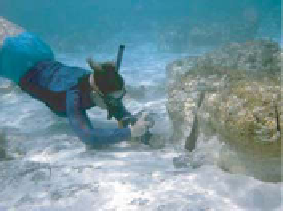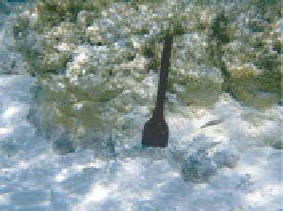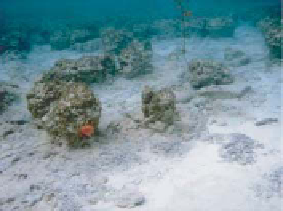Geology Reference
In-Depth Information
(a)
(b)
(c)
(d)
Fig. 6.
Back reef lagoon at Site 1 illustrating
the relationship between the underlying basal
coral surface and overlying columnar stromato-
lite development. (a) Large rounded boulders on
undulating basal surface; columnar stromatolites
~40 cm high. (b & c) Relationship between gray-
blackened basal surface outcropping as sand
(white) is washed out of back reef lagoon reveal-
ing stromatolite growth directly on this surface;
columnar stromatolites ~40 cm high. (d) Small
brain coral (under chisel:
Siderastraea radians:
sample H-0410-bsc-1.2) encrusting basal part
of stromatolite column dated at 566
(e)
(f)
11 years.
Chisel is 30 cm long for scale. (e) Platy brain
coral (
Diploria strigosa
; sample H-0410-bsc-1.3)
dated at 667
12 years. Knife is 25 cm long
for scale. (f) Platy brain coral (
Diploria clivosa
;
sample H-0410-bsc-1.1) dated at 790
11 years.
Chisel is 30 cm long for scale.
Basal surface underlying stromatolites
the basal corals at Highborne Cay were unknown.
These outcrop relationships thus provided the
unique opportunity to not only date the reef below
the stromatolites but also to determine the max-
imum age of the stromatolite build-ups.
In October 2004 strong longshore currents over
an extended period washed out most of the sand
from the back-reef lagoon - exposing the basal
surface of the back-reef stromatolites (Fig. 6). At
the basal surface is a grey to dark grey, partially
black, smoothly eroded hard surface. Large well-
rounded pebbles to boulders (Fig. 6a) are scattered
throughout the surface but tend to accumulate
in depressions. Parts of the surface are overgrown
by knobbly microbial mat. On closer inspection,
numerous centimetre to decimetre-sized platy
corals (Fig. 6e and f) and encrusting brain cor-
als (Fig. 6c and d) were found within the grey to
blackened basal surface (Fig. 5). Corals were iden-
tifi ed as
Diplorian strigosa and clivona
as well as
Siderastraea radians
. Within a few centimetres,
corals lie within the same horizontal plane. Most
interesting is the relationship between this basal
surface and stromatolites: all stromatolites grow
off the basal surface (Fig. 6a-d). Small, ~10 cm
encrusting
Siderastraea radians
heads grow at the
base of some stromatolite build-ups (Fig. 6d).
Stromatolites have been notoriously diffi cult to
date - previously, the age of the stromatolites and
Material and methods
Coral samples
Ages were determined on four coral samples
chiselled from the basal surface in October
2004 (Fig. 6). Two dated corals (H-0410-bsc-1.1,
Fig. 6f, and H-0410-bsc-1.3, Fig. 6e) and the sec-
tioned stromatolite head lie on an E-W transect
across the northern part, the other dated coral sam-
ples (H-0410-bsc-1.2, Fig. 6d, and H-0410-bsc-1.4)
are projected onto the transect line (Fig. 4). Coral
samples were vertically sectioned and inspected
for early diagenetic overprint; they displayed a
pristine appearance under the blackened surface.
Stromatolite samples
One columnar stromatolite was vertically sectioned
using a hand saw, leaving half the stromatolite






